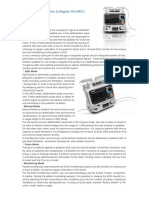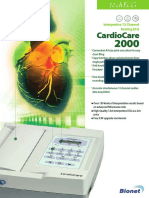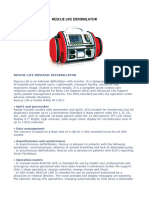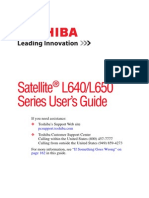MWT Beat-Watch Defibrillator: Product Technical File Summary
MWT Beat-Watch Defibrillator: Product Technical File Summary
Uploaded by
Ahmed El KadyCopyright:
Available Formats
MWT Beat-Watch Defibrillator: Product Technical File Summary
MWT Beat-Watch Defibrillator: Product Technical File Summary
Uploaded by
Ahmed El KadyOriginal Description:
Original Title
Copyright
Available Formats
Share this document
Did you find this document useful?
Is this content inappropriate?
Copyright:
Available Formats
MWT Beat-Watch Defibrillator: Product Technical File Summary
MWT Beat-Watch Defibrillator: Product Technical File Summary
Uploaded by
Ahmed El KadyCopyright:
Available Formats
Product Technical File Summary
MWT Beat-Watch Defibrillator
FIELDS OF APPLICATION Health problem addressed Defibrillators are lifesaving devices that apply an electric shock to establish a more normal cardiac rhythm in patients who are experiencing ventricular fibrillation (VF) or another shockable rhythm. Product description The defibrillator charges with a large capacitor. For external defibrillation, paddles are needed to discharge on the patients chest. Disposable defibrillation electrodes may be used as an alternative. For internal defibrillation small concave paddles are used. An ECG monitor included is used to verify a shockable rhythm and the effectiveness of treatment. The defibrillator can be equipped with optional monitoring capabilities, such as pulse oximetry, end -tidal carbon dioxide and NIBP. VERSATILE Light, Strong, comfortable strap Designed without sharp edges, ideal for emergency transport. The battery, which is easy to replace, allow more than 100 shocks. EASY OF USE All operations are concentrated in only two buttons. Ready to use in less than 6 seconds. Biphase power delivery of up to 360 Joules. PRACTICAL Easy operation -1, 2, 3 standard. Clear interface and quick access main functions. SMART Innovative interface that automatically adjusts to the number of parameters, presenting the important information in a clearer and more organized way. Smart monitoring alarms. ADVANCED Equipped with the AED (Automated External Defibrillator) Mode, Beat -Watch becomess even more compete and appropriate, being ideal for accompaniment of high patients because it has Sudden Death Prevention (SDP) technology. This characteristic allows Beat-Watch to monitor the patient continually and indentify the beginning of ventricular Fibrillation or rapid Ventricular Tachycardia episode. In this Situation, the equipment activates a visual and sound alarm, allowing the patient to be treated with shock in a much shorter time, significantly increasing the chances of reversing cardiorespiratory arrest. Standardisation Device Classification (Defined by 93/42/EEC Directive) CE Marking Quality System Certified to 1 Class IIA Rule 6 C001612 ISO13485:2003 & ISO9001:2008 MWT Beat-Watch Defibrillator
Product Technical File Summary
GENERAL SPECIFICATIONS Dimensions with pads: 30,0 cm (11.81 in) length, 21,5 cm (8.46 in) depth,28,0 cm (11.02 in) height. Weight: Device - 4.90 Kg (10.80lbs), Battery - 0.75 Kg (1.65 lbs),Ext. pads - 0.85 Kg (1.87 lbs). Complete Equipment 6.50 Kg (14.33lbs). Electrical: AC: 100 to 265 VAC, 50/60 Hz (automatic selection), DC external: 11 to 16 VDC. Replaceable battery: Type: NiMH, 14.4 VDC 4.5 A/h. Duration: Battery with full charge 3.5 hours in monitor mode, without printer, or a minimum of 140 shocks at 360 joules or a minimum of 200 shocks at 200 joules. Memory: Type: Nand Flash, Capacity: 2 Mbytes. Patients stored >150 patients. Storage: 15 seconds of ECG when in shock, physiological alarm and panel events. ENVIRONMENTAL SPECIFICATION Temperature: Operational: 0 to 50 C, Storage: 0 to 70C Humidity: Operational: 10 to 95% RH, without condensation, Storage Electrode size: Adult: 10,3 cm (4,05 in) x 8,5 cm (3,34 in). Contact area: 81,9 cm2 (12,69 inches2) Children: 4,5 cm (1,77 in) x 4,0 cm (1,57 in). Contact area: 18 cm2 (2,79 inches2) Cardioversion: < 60ms Pads (options): Adult and child external (included), Adult and child internal (optional), Multifunctional for pacemaker, monitoring and defibrillation (optional), Multifunctional exten sion (optional). DISPLAY Battery level indicator: Yes. Size: 9,93 cm (3,90 in) x 13,24 (5,21 in) cm. Diagonal: 6,5". Type: LCD TFT color. Resolution: 640 x 480 pixels (VGA). Scan speed: 12.5; 25 and 50 mm/s. ECG (up to 12 derivations) Inputs: 3, 5 or 10 lead ECG cable, External pads, Multifunctional pads. Range: 15 to 350 BPM, Precision: +/1 BPM from 15 to 350 BPM. Rejection in common mode: Greater than 90 dB, measured according to AAMI standards for heart monitors (EC 13). NIBP (OPTIONAL) Operating principle: Oscillometric. Automatic measurement mode: 1, 2, 3, 4, 5, 10, 15, 30, 60 and 90 minutes Manual: One measurement. Measurement interval: Adult: Systolic: 40 - 260 mmHg, MAP: 26 220 mmHg, Diastolic: 20 - 200 mmHg. Pediatric: Systolic: 40 - 160 mmHg, MAP: 26 133 mmHg, Diastolic: 20 - 120mmHg. Neonate: Systolic: 40 - 130 mmHg, MAP: 26 110 mmHg, Diastolic: 20 - 100 mmHg. Overpressure limit by software: Adult: 290 mmHg max. Neonate: 145 mmHg max. Overpressure protection by hardware: Adult: 300 mmHg. Neonate: 150 mmHg. Resolution: 1 mmHg. DEFIBRILLATOR Waveform: Biphasic truncated exponential. Waveform parameters adjusted in terms of patients impedanceShock application: Multifunction adhesive Pads, Defibrillation Pads Adult/external defibrillation: Scales: 1, 2, 3, 4, 5, 6, 7, 8, 9, 10, 20, 30, 40, 50, 80, 100, 150, 200, 250, 300 and 360 Joules. Maximum power limited to 50 J with internal or childrens pads Controls: On/Off button, charge, shock, synchronism Po- wer selection: Therapy button on the front panel Charge control: Button on the front panel, button on the external pads Shock control: Button on the front panel, buttons on the external pads Synchronized control: SYNC button on the front panelCharge indicators: Sound signal of equipment being charged, Sound signal of completed charge, LED on ex-ternal pads and charge level indicated on the display.
Maximum charging time: (200J) Network and battery < 4s, (360J) Network and battery < 6s Sensitivity: 5, 10, 15, 20, 30 and 40 mm/mV. AC line filter: 60 Hz or 50 Hz. ECG response frequency: Diagnostic mode - (0,05 -100 Hz), Monitor Mode - (1-40 Hz). Patient insulation: Defibrillation proof. ECG: CF Type. SPO2: CF Type. shown with Loose Electrode: Identified and low level alarm. Defibrillator discharge: < 5 seconds.
MWT Beat-Watch Defibrillator
Product Technical File Summary
OPTIONS
EXTERNAL PACEMAKER (OPTIONAL) Modes: Demand or fixed. Amplitude: From 5 mA to 200 mA (resolution of 5 mA), accuracy 10%. Pulse width: 20 ms (+/- 1ms). Frequency: From 30 ppm to 180 ppm (increments of 5 ppm), accuracy 2%. Refractory period: 340 ms (from 30 to 80 ppm), 240 ms (from 90 to 180 ppm). AED MODULE (OPTIONAL) Functional characteristics: Voice in structions, visual indications, CPR instructions, USB 2.0. Multilanguage, Sudden Death Prevention Technology (SDP). USB: USB 2.0 for transfer of the electrocardiogram stored in AED mode to a compatible PC. SoftDEA: Software for viewing the data transferred to the PC. CAPNOGRAPHY (OPTIONAL): Measurement range; CO2: 0 99 mmHg Precision: +/- 3% from 0 to 40 mmHg, +/- 8% from 41 to 76 mmHg<+/- 10% from 77 to 99 mmHg. Calibration: two points Start: 10 seconds for CO2 curve start, Less than 3 minutes for complete functioning. Consumption: 0,8 W Compensation: BTPS, N2O, O2
PRINTER (OPTIONAL) Type: Thermal. Weight: 0,4 KG. Speed: 12.5; 25 or 50 mm/s with precision of 5%. Paper size: 50 mm (width) x 30 m (maximum length). SpO2 (OPTIONAL) SpO2 range: 0 to 100 %. Pulso range: 30 to 250 BPM. SpO2 precision: +/- 2 % from 70 to 100%, +/- 3 % from 50 to 69%, Pulse Precision: +/- 2 BPM Scan speed: 12.5; 25 and 50 mm/s STANDARDS: EN 60601-1:1990 (A1:1993, A2:1995, A13:1996) NBR IEC 60601-1:1994 + emenda 1997 EN 60601-1-2:2007 NBR IEC 60601-1-2:2006 EN 60601-2-4:2003 NBR IEC 60601-2-4:2005 EN 60601-2-25:1995 (A1:1999) EN 60601-2-27:2006 NBR IEC 60601-2-27:1997 EN 60601-2-49:2001 NBR IEC 60601-2-49:2003
MWT Beat-Watch Defibrillator
You might also like
- Technical Specification Instramed Cardiomax NewDocument6 pagesTechnical Specification Instramed Cardiomax NewDwi SanitaNo ratings yet
- B20 Specs Sheet - Mature MarketDocument4 pagesB20 Specs Sheet - Mature MarketShimon Doodkin0% (1)
- Technical Specification INSTRAMED - Cardiomax2Document2 pagesTechnical Specification INSTRAMED - Cardiomax2Dwi SanitaNo ratings yet
- Product Details of Contec CMS8000 Patient Monitor CMS8000 6-ParameterDocument8 pagesProduct Details of Contec CMS8000 Patient Monitor CMS8000 6-ParameterMiguel PatrickNo ratings yet
- Specifications For Medical Equipment OPDocument66 pagesSpecifications For Medical Equipment OPshihabNo ratings yet
- Lifepak9 SpecsDocument2 pagesLifepak9 Specsaguspal8No ratings yet
- Defibrillator Life GainDocument5 pagesDefibrillator Life GainhasyikinNo ratings yet
- XyzDocument2 pagesXyzaomltNo ratings yet
- CA Cs100 Product-Specifications 0564-Rev-B EngDocument6 pagesCA Cs100 Product-Specifications 0564-Rev-B EngAdrián López MorenoNo ratings yet
- Delta XL DsDocument8 pagesDelta XL Dsdex99No ratings yet
- Zoll MSeriesDocument2 pagesZoll MSeriessheshagiribNo ratings yet
- Philips Goldway UT4000A Patient Monitor1Document2 pagesPhilips Goldway UT4000A Patient Monitor1Quach TraNo ratings yet
- 3678 033 GE Responder 2000 With PacingDocument4 pages3678 033 GE Responder 2000 With PacingAhmad HamdounNo ratings yet
- Metrax Produktdatenblatt Evo 1304 2 enDocument2 pagesMetrax Produktdatenblatt Evo 1304 2 enFrancisco HernandezNo ratings yet
- All Product Catalog 2021Document40 pagesAll Product Catalog 2021nuelvaNo ratings yet
- Defi Xpress Advanced DefibrillatorDocument2 pagesDefi Xpress Advanced DefibrillatorAlex LinNo ratings yet
- Welch Allyn PIC-30Document2 pagesWelch Allyn PIC-30servicioNo ratings yet
- ZOLL® PD™ 1400: SpecificationsDocument1 pageZOLL® PD™ 1400: SpecificationsfranzNo ratings yet
- GE Tonoport IV User ManualDocument2 pagesGE Tonoport IV User ManualMULTIMED ENGINEERINGNo ratings yet
- Cardio ServDocument4 pagesCardio Servleopa78No ratings yet
- Beds Monitoring FacilitiesDocument4 pagesBeds Monitoring FacilitiesMuneeb Ali100% (1)
- Schiller Truscope II BrochureDocument2 pagesSchiller Truscope II BrochureGhulam HyderNo ratings yet
- Monitor de Signos Vitales CONTEC CMS 8000 CON ETCO2Document4 pagesMonitor de Signos Vitales CONTEC CMS 8000 CON ETCO2leopa78No ratings yet
- DefiMonitor EVODocument2 pagesDefiMonitor EVOvendulka.keclikovaNo ratings yet
- Z5 Datasheet v2.0 - 20131024Document15 pagesZ5 Datasheet v2.0 - 20131024miljenkoNo ratings yet
- Extech 407750 ManualDocument8 pagesExtech 407750 ManualTuấn LêNo ratings yet
- 1205 Cxa TDRDocument2 pages1205 Cxa TDRtapasNo ratings yet
- Spesification: Patient MonitorDocument3 pagesSpesification: Patient Monitoralfridasulo limbonganNo ratings yet
- Z5 Datasheet v1.0 - 20120929Document15 pagesZ5 Datasheet v1.0 - 20120929Sergio Alejandro CastroNo ratings yet
- Vsign200 CardiolineDocument8 pagesVsign200 Cardiolinezaidtech1010No ratings yet
- Bci-Cat-9200 Advisor Vital Signs MonitorDocument2 pagesBci-Cat-9200 Advisor Vital Signs MonitorAbraham AlmirudisNo ratings yet
- Spesifikasi Patient Monitor: Draeger - Vista 120S: Type Parameter Merk FEATURESDocument2 pagesSpesifikasi Patient Monitor: Draeger - Vista 120S: Type Parameter Merk FEATURESRicky LNo ratings yet
- Argus LCX: Convenient Vital Data Patient MonitoringDocument4 pagesArgus LCX: Convenient Vital Data Patient MonitoringAzhari DasrilNo ratings yet
- Calalogo Cardioversor HP CodemasterDocument5 pagesCalalogo Cardioversor HP Codemasteralcideslup85.85No ratings yet
- Spesifika Si Patient Monitor: Draeger - Vista 120S: Type Parameter Merk FEATURESDocument2 pagesSpesifika Si Patient Monitor: Draeger - Vista 120S: Type Parameter Merk FEATURESRicky LNo ratings yet
- Specification: NC 12: Shenzhen Comen Medical Instruments Co.,LtdDocument6 pagesSpecification: NC 12: Shenzhen Comen Medical Instruments Co.,LtdXinwen ChenNo ratings yet
- Merk: Primedic - Germany Type: Defimonitor XD 3 SpecificationDocument3 pagesMerk: Primedic - Germany Type: Defimonitor XD 3 SpecificationyulizarNo ratings yet
- Comen STAR8000H Bedside Patient MonitorDocument4 pagesComen STAR8000H Bedside Patient MonitorMohammed MudesirNo ratings yet
- Ecg 12CDocument4 pagesEcg 12CjesusNo ratings yet
- Technical Specification-ECG-1210 OLD Version V1.1Document8 pagesTechnical Specification-ECG-1210 OLD Version V1.1Poushi AdhikaryNo ratings yet
- Monitor Signos Vitales Goldway Ut4000aDocument2 pagesMonitor Signos Vitales Goldway Ut4000asolcarwxNo ratings yet
- Chison Ivis 60Document18 pagesChison Ivis 60Sergio Alejandro Castro MelendezNo ratings yet
- CardioCare2000 ECG EKG BrochureDocument2 pagesCardioCare2000 ECG EKG BrochureInfo NlmsNo ratings yet
- Cardiocare: Interpretive 12 Channel Resting EcgDocument2 pagesCardiocare: Interpretive 12 Channel Resting EcgNice BennyNo ratings yet
- Data Spek ECG 12 Channel 2212BDocument4 pagesData Spek ECG 12 Channel 2212BNorman RSNo ratings yet
- Cleo Brochure 2015Document6 pagesCleo Brochure 2015WaleedNo ratings yet
- Comen Star 8000fDocument2 pagesComen Star 8000fAhmed NourNo ratings yet
- ReslifeDocument3 pagesReslifeLê Hồng AnhNo ratings yet
- Spesifikasi Vista 120 S Patient Monitor - Invasive BayiDocument2 pagesSpesifikasi Vista 120 S Patient Monitor - Invasive BayinafisNo ratings yet
- Drager Infinity Delta Datasheet and Delta XLDocument8 pagesDrager Infinity Delta Datasheet and Delta XLClaudio Roberto da CostaNo ratings yet
- Spesifikasi Vista 120 S Patient Monitor - StandardDocument2 pagesSpesifikasi Vista 120 S Patient Monitor - StandardHadi AtmojoNo ratings yet
- Technical Specification Instramed Cardiomax New - 2 PDFDocument6 pagesTechnical Specification Instramed Cardiomax New - 2 PDFDwi SanitaNo ratings yet
- Datascope 98XT BrochureDocument2 pagesDatascope 98XT BrochureFelipe ValenciaNo ratings yet
- Bionet CardioTouch 3000 ECG EKG LeafletDocument2 pagesBionet CardioTouch 3000 ECG EKG LeafletLuis Alberto Castillo MaurtuaNo ratings yet
- TRFM 21KBDocument5 pagesTRFM 21KBNada Al-qubatiNo ratings yet
- Spesifikasi Vista 120 Patient Monitor - InvasiveDocument2 pagesSpesifikasi Vista 120 Patient Monitor - InvasiveIqbhal RamadhanNo ratings yet
- Patient MonitorDocument5 pagesPatient MonitorPaleh Tath GanaihNo ratings yet
- DM7000KDocument4 pagesDM7000Kzora tecNo ratings yet
- Analog Dialogue Volume 46, Number 1: Analog Dialogue, #5From EverandAnalog Dialogue Volume 46, Number 1: Analog Dialogue, #5Rating: 5 out of 5 stars5/5 (1)
- Maquet FlowDocument317 pagesMaquet FlowAhmed El KadyNo ratings yet
- sm785 Cs-8100-Family SR Ed16 English enDocument44 pagessm785 Cs-8100-Family SR Ed16 English enAhmed El KadyNo ratings yet
- Ga Wash-Master Classic en 2016-07-20.semnatDocument66 pagesGa Wash-Master Classic en 2016-07-20.semnatAhmed El KadyNo ratings yet
- Flowfast HDocument6 pagesFlowfast HAhmed El KadyNo ratings yet
- Dubuque Management of Clinical Alarms SystemsDocument6 pagesDubuque Management of Clinical Alarms SystemsAhmed El KadyNo ratings yet
- Arjo - Flowtron Excel Specs Sheet.1.0.INT - ENDocument4 pagesArjo - Flowtron Excel Specs Sheet.1.0.INT - ENAhmed El KadyNo ratings yet
- Management of Clinical AlarmsDocument3 pagesManagement of Clinical AlarmsAhmed El KadyNo ratings yet
- Technical Manual NP V15 PDFDocument20 pagesTechnical Manual NP V15 PDFAhmed El KadyNo ratings yet
- IPC Rigid Vinyl Wall Cladding SpecificationsDocument2 pagesIPC Rigid Vinyl Wall Cladding SpecificationsAhmed El KadyNo ratings yet
- AesculapDocument60 pagesAesculapAhmed El Kady67% (3)
- Facility Layout PaperDocument13 pagesFacility Layout PaperAhmed El KadyNo ratings yet
- Optimization of Shunt Compensation For Voltage Stability ImprovementDocument11 pagesOptimization of Shunt Compensation For Voltage Stability ImprovementSanthosh Reddy KanthalaNo ratings yet
- Charged Particle in A Magnetic FieldDocument4 pagesCharged Particle in A Magnetic FieldBenjaminMainNo ratings yet
- MA4PK200x 3000x SeriesDocument9 pagesMA4PK200x 3000x SeriesGuanghui ZhuNo ratings yet
- Risk AnalysisDocument8 pagesRisk Analysiscarlitos8022No ratings yet
- FCM 1 RelDocument2 pagesFCM 1 RelSherman de la Fuente100% (5)
- 057-271 A106MKII SoftDocument28 pages057-271 A106MKII SoftArsen SemenystyyNo ratings yet
- 485opdr Hs 4713ds PDFDocument2 pages485opdr Hs 4713ds PDFEduardo_77No ratings yet
- DyeDocument12 pagesDyeVeby LamanepaNo ratings yet
- Micro Project: Government Polytechnic, VikramgadDocument25 pagesMicro Project: Government Polytechnic, VikramgadViresh bhoirNo ratings yet
- Toshiba Servo Drive PresentationDocument24 pagesToshiba Servo Drive PresentationRSX SNo ratings yet
- SeismicDetector PC KSM2017enDocument8 pagesSeismicDetector PC KSM2017enDaniel LowNo ratings yet
- CSE DEPT LIBRARY Total Book List Until January2014 PDFDocument24 pagesCSE DEPT LIBRARY Total Book List Until January2014 PDFasdfhh0% (1)
- The OS, The Computer, and User ProgramsDocument33 pagesThe OS, The Computer, and User Programskadappa beniwadiNo ratings yet
- Fabrication of Multi-Purpose Solar UmbrellaDocument13 pagesFabrication of Multi-Purpose Solar UmbrellaIJRASETPublicationsNo ratings yet
- Toshiba Satellite L650 12Q Laptop ManualDocument229 pagesToshiba Satellite L650 12Q Laptop ManualTasos KachpanisNo ratings yet
- VLSI Physical Design Prof. Indranil Sengupta Department of Computer Science and Engineering Indian Institute of Technology, Kharagpur Lecture - 01Document16 pagesVLSI Physical Design Prof. Indranil Sengupta Department of Computer Science and Engineering Indian Institute of Technology, Kharagpur Lecture - 01Nahin AminNo ratings yet
- Studi Manual ListrikDocument194 pagesStudi Manual ListrikMassolo RoyNo ratings yet
- Unit6 Combined ControllerDocument20 pagesUnit6 Combined ControllerOMKAR PATILNo ratings yet
- Act 6 - The Shell ModelDocument8 pagesAct 6 - The Shell ModelDupa JasiuNo ratings yet
- Homecharger: Type 1 Plug Type 2 Plug Type 2 SocketDocument2 pagesHomecharger: Type 1 Plug Type 2 Plug Type 2 Socketdario_baptista4237No ratings yet
- Easy Boot User ManualDocument2 pagesEasy Boot User ManualMuse My100% (1)
- Index: S.N0 Content Page NoDocument15 pagesIndex: S.N0 Content Page Nokanishka.y05No ratings yet
- Database Migration From Windows To Linux Using RMAN: List of Steps Needed To Complete The MigrationDocument10 pagesDatabase Migration From Windows To Linux Using RMAN: List of Steps Needed To Complete The MigrationDrishti GuptaNo ratings yet
- Manual SIRIUS Soft Starter en-USDocument226 pagesManual SIRIUS Soft Starter en-UStrung_tuanNo ratings yet
- Complete Walkthrough of QuellDocument14 pagesComplete Walkthrough of QuellNat MaiNo ratings yet
- The RF Line NPN Silicon Power Transistor 100W, 30-200Mhz, 28VDocument6 pagesThe RF Line NPN Silicon Power Transistor 100W, 30-200Mhz, 28VBhert DjbsevenNo ratings yet
- KoyoDocument14 pagesKoyoRaul FelipeNo ratings yet
- E-Series Commercial Solar Panels: Supplementary Technical SpecificationsDocument4 pagesE-Series Commercial Solar Panels: Supplementary Technical SpecificationsJesus David Muñoz Robles0% (1)
- Exploded View & Part ListDocument21 pagesExploded View & Part Listsonic8659No ratings yet
- De Edu TaskDocument13 pagesDe Edu Taskamos.otienoNo ratings yet




































































































